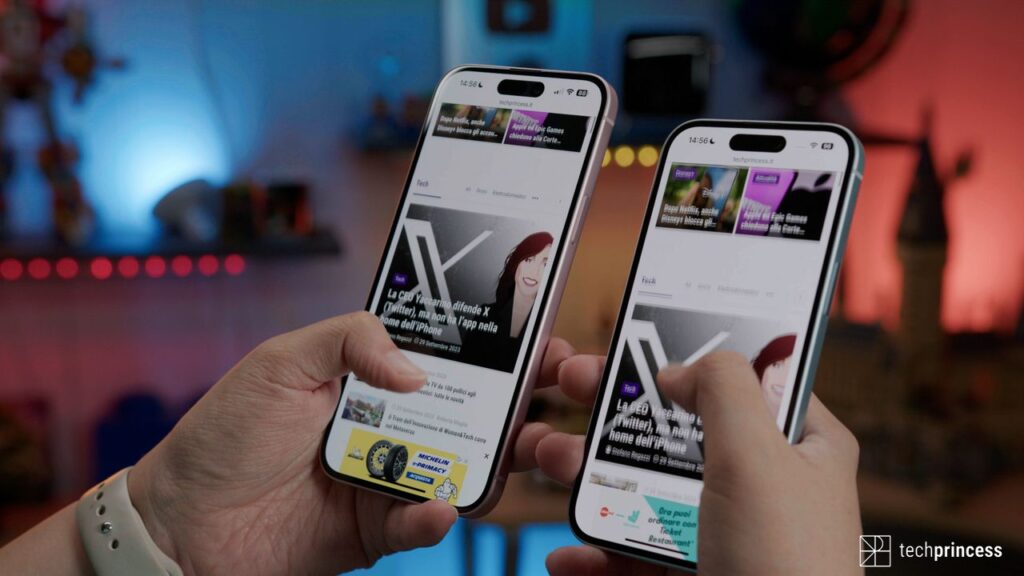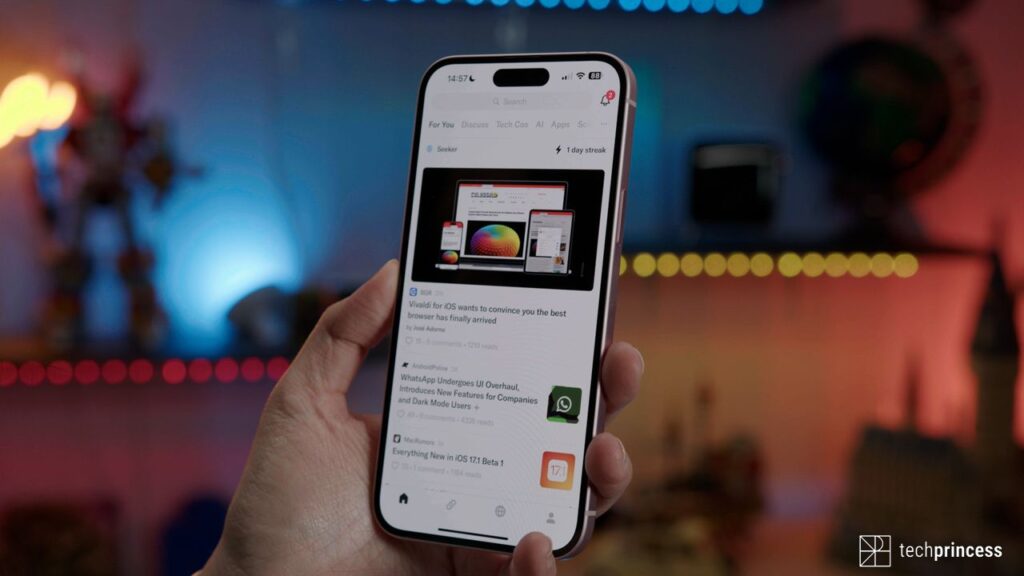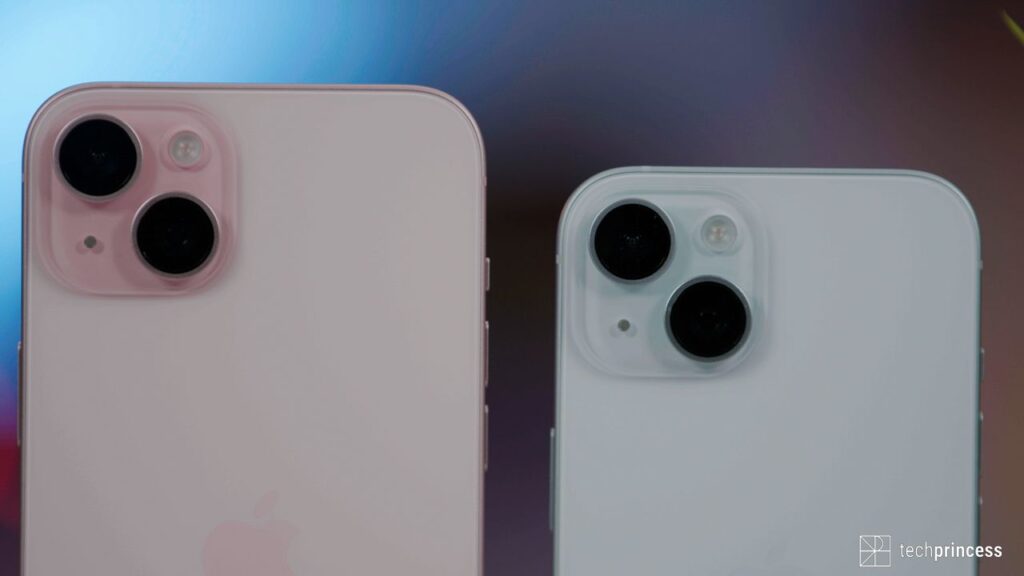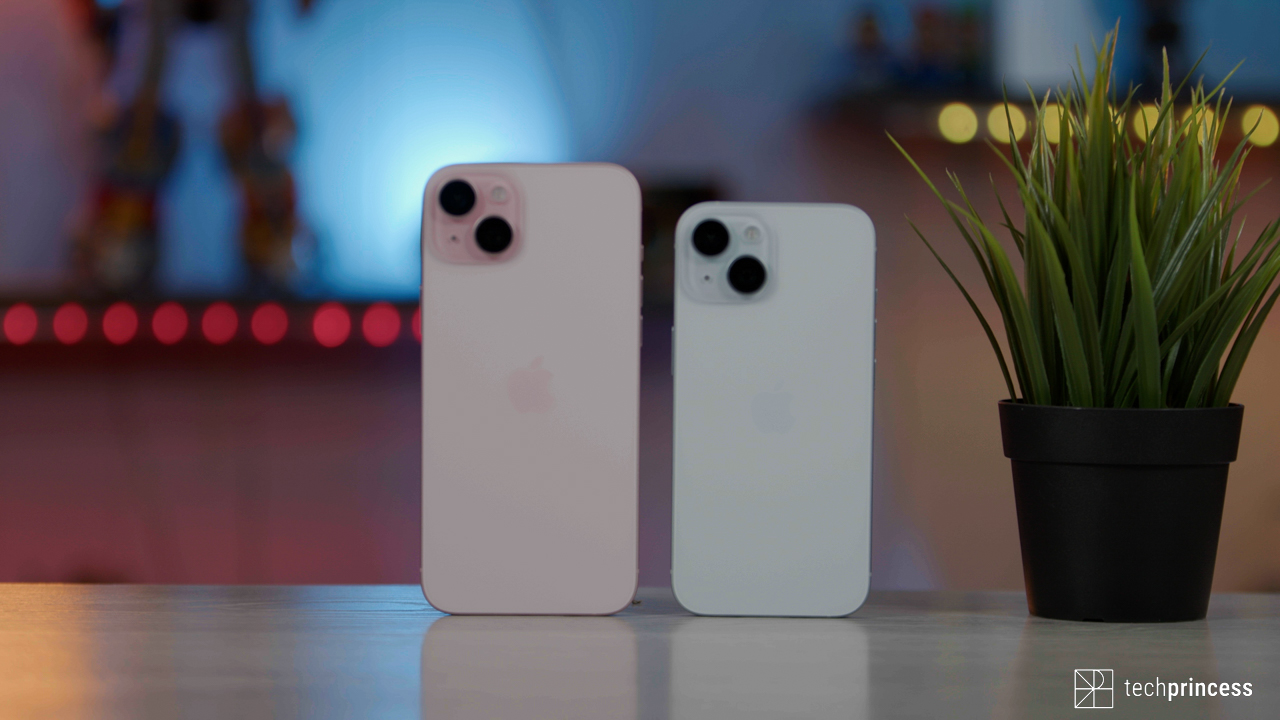The first thought when faced with iPhone 15 e iPhone 15 Plus it was “yes, an easy review!”.
But no. We were wrong.
It is clear that the “basic” models do not offer us all the innovations of the Pro models. But this complicates things instead of simplifying them.
iPhone 15 vs iPhone 15 Plus: what are the differences?
iPhone 15 and 15 Plus are practically identical.
However, the dimensions change this is evident. And the larger size of the 15 Plus has two consequences.
The first is that iThe display is 6.7 inches instead of 6.1 inches. Always OLED. Always a feast for the eyes. Always with a peak brightness that is now arriving a 2000 nitswhich means that visibility under the sun has actually increased. We compared it with the iPhone 13 and yes, the difference outdoors is very evident.
Bigger display means of course more space available for reading, watching videos, surfing the Internet and much more.

The second consequence is autonomy. We used the iPhone 15 for a few days and on average we spent 4 and a half hours with the screen on, with the 15 Plus we reached almost 7 hours.
For everything else, the iPhone 15 and 15 Plus are practically the same phone. A great phone. And this doesn’t surprise us. And we imagine it doesn’t surprise you either.
This review therefore does not serve to establish whether or not it is worth spending a minimum of 979 euros for this product because it is clear that it is worth the amount requested by Cupertino.
However, there are a series of elements that we would have expected to find on a phone that costs 1000 euros and which instead are not there.
What are these things? And why aren’t they there?
What’s missing from the iPhone 15/15 Plus?
We need to have a discussion upstream.
At one point in Apple’s history, we ended up with four phones.
In the beginning it was one, the iPhone. Stop.
Four smartphones are more complex to manage, to design, to innovate, however it makes sense to have them because Apple gives consumers – us – the choice.
To choose how advanced we want it.
To choose how big we want it.
To choose how much memory we need.
To choose which color we want it.
And the choice is important. Because deep down we don’t like people imposing something on us. Not to mention that in 2023 we love to stand out from others, and the expansion of the US company’s offering allows us to do so.
These four models today are clearly divided into two bands: the “basic” one, which starts from 979 euros, and the Pro one, that require at least 1,239 euros.
These two families cannot be the same and at the same time we expect them both to evolve every year, so in Cupertino they made a choice: bring some features from previous year’s Pro models to current year’s base models.
The key is SOME.
Not all.
Because in any case a certain distinction must be maintained between the two bands.
And this answers why features that would be legitimate to have on the basic models are not actually there.
But now let’s try to understand what these shortcomings are.
USB-C: we stop at 2.0

The first is undoubtedly a technicality, a specification for enthusiasts.
Let’s try to explain it to you.
The biggest news of the iPhone 15 and 15 Plus, at least in our opinion, is the USB-C connector.
We talked about choice but it is worth pointing out that this is not exactly a free choice by Apple.
This is the European Union that has decided it wants a single connector and that single connector, valid for more or less any electronic device, is Type-C.
Apple therefore, like it or not, had to abandon the Lightning connector.
For us this is a clear plus.
Beyond the Lightning cables purchased in the past and ready to be abandoned in a drawer forever, having USB-C means being able to use a charger for everything: PC, tablet, phone, headphones… whatever. And not just Apple’s, but all of them. Even those of relatives who use Android.
For Apple this is an economic loss, because the license to use the Lightning connector has a cost for those who produce accessories. It’s money for the company led by Tim Cook, money that will no longer enter Cupertino’s coffers.
And this might make us think that iPhones cost less this year – and yes, they cost less – because they want to sell more of them to try to offset the losses resulting from USB-C.
Obviously this is our hypothesis, it is not necessarily true.

But let’s get back to USB-C. It’s there on the iPhone 15. It’s there on the iPhone 15 Plus. But it’s not the same as the Pro models.
USB-C is here in version 2.0 which, to simplify, means that it is 20 times slower than USB 3.0 which instead we have on the Pro. Here the transfer speed is 480 Megabits per second, on the other side we have 10 Gigabits per second.
Now, if we are to be realistic, we don’t know how many times you will connect your phone to your PC and transfer data. Some of you could simply use a cable to transfer data from the old phone to the new one, taking a little longer than the Pros but taking into account that it is an operation you only do once. This means that the daily impact of this 2.0 could be almost non-existent but, despite everything, we would have expected a 3.0 because, we repeat, it takes at least 979 euros for the iPhone 15, which is quite a lot.
iPhone 15 and 15 Plus review: no 120 Hz and no always-on

We confirm it: the display remains a pleasure to use but we stop at 60 Hz.
We understand that the ProMotion elevates the Pro models and, in all probability, it is called Pro-Motion to recall the Pro models.
However, we cannot ignore the fact that many smartphones, which are significantly cheaper, now come with a refresh rate of 120 Hzwhich is exactly what the ProMotion offers.
We would therefore expect at least 90 Hz on the basic models, because the greater fluidity improves the user experience, both in viewing content and in gaming and in daily use.
The screen also lacks the always-on displayanother element now widespread in the competition.
However, this amazes us more because there is a function in iOS 17, the Standby mode, which is perfect together with the always-on display: rotate the terminal during the night while it is charging and you can always see what time it is as well as being able to interact with notifications and widgets. On the iPhone 15 and 15 Plus, however, you have to tap on the display to see it precisely because, as there is no always-on feature, the screen cannot always remain on.
It’s a small thing, we realize. In the end, a tap is a gesture that doesn’t take up time but in 2023 limiting this function to the Pro family we still don’t think it makes sense.
The mirage of the telephoto lens

Finally, there is one last thing that we would like to have but is absent: the telephoto lens.
Here, however, we can understand Cupertino’s choice even if it is increasingly difficult to agree with it.
Why do we understand? Because it is, to date, one of the biggest differences with the Pro models.
Considering that the zoom of the Pros reaches a maximum of 5x, which is not much compared to other smartphones on the market, inserting it also on the iPhone 15 and 15 Plus, even if only in a weakened version, it meant flattening the differences too much. And the differences define sales.
Why don’t we share it instead? Because it makes sense but it’s also true that it’s not difficult to think of a top of the range camera that doesn’t have a telephoto lens.

However, Apple tried to find a compromise this year. On the 15 and 15 Plus we have a 2x digital zoom which was born as a sensor crop, which means that the photo is taken with the main sensor – 48 megapixels – and then a portion is cropped which becomes your 2x.
It’s not like the optical one but it works well.
The camera is still a guarantee
Since we are talking about the photographic sector, let’s go into a little more detail.
Remember when we said that this year’s base models inherit things from last year’s Pros? Well, this is not the case.
One of the new features of the iPhone 14 Pro and Pro Max was the 48 megapixel sensor.
On iPhone 15 and 15 Plus we have 48 megapixels but the sensor is not the same. It’s smaller, with a lens that’s a 26mm equivalent, and doesn’t deliver the same performance as either the 15 Pro or the 14 Pro.
It represents though a good step forward because we have found a 12 megapixel sensor on iPhones since 2015. From the iPhone 6s. It was time for a change.
The difference can be seen.
We used iPhone 13 for the comparison because its photographic sector is very similar to the 14 and you can easily notice the difference by zooming in a little on the photos.
iPhone 15 gives us more details. Those extra megapixels are therefore useful, and they are well optimized. So much so that the newcomer captures 24 megapixel images which however do not think much. Just a hair more than 12 megapixels. However, with a quality that is significantly greater.
You can still shoot at 12 megapixels if you want to save space. Or you can shoot at 48 megapixels if you have taken 512 GB and space is not an issue.
However, be aware that in both cases you will have to use the menu to change the size of the photo.
Regardless of this parameter, you can then choose whether to have the files in HEIF format, which is designed to save space but have high quality, or use JPGs.
However, there is no RAW which remains exclusive to the Pro models.
How are the shots?
Beautiful. It’s undeniable. iPhone is the.















Leave a Reply
View Comments